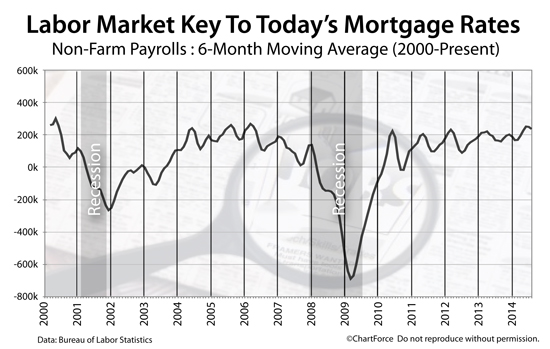Current Mortgage Rates Nearing 16-Month Best But Threatened By Friday’s Jobs Report

Mortgage Rates And The Jobs Report
On the first Friday of each month, the Bureau of Labor Statistics publishes the Non-Farm Payrolls report. Commonly called "the jobs report", Non-Farm Payrolls highlights employment changes across 10 private labor market sectors including insurance and finance.
Wall Street watches Non-Farm Payrolls closely. The report affects today's mortgage rates. Among the reasons why is that the Federal Reserve's stimulus programs are linked to the U.S. jobs economy, and the Fed has actively held current mortgage rates down.
September's Non-Farm Payrolls will be released Friday. With a better-than-expected read, mortgage rates and APRs are expected to climb. With a worse-than-expected read, mortgage interest rates are expected to fall.
Click for today's live mortgage rates.
8.9 Million Jobs Added Since 2010, 159k Per Month
The Non-Farms Payrolls report is a broad look at the U.S. labor market. By industry, it shows which economic areas are expanding, and which areas are contracting. It also reports the U.S. unemployment rate.
Non-Farm Payrolls is a monthly Wall Street highlight. Job growth is paramount to economic growth, and economic growth drives investment strategy.
Recently, the jobs report's importance has been magnified. This is because the Federal Reserve is actively stimulating the economy and its programs will continue so long as the economy requires it.
One such program is QE3. Via QE3, the Fed actively suppresses U.S. mortgage rates to below-market levels. The Fed believes low rates stimulate the housing market which, in turn, helps to create jobs in construction, retail, and banking.
Low mortgage rates spur refinances as well, which increase household savings and contribute to higher levels of consumer spending.
Many banks now offer mortgage rates in the 3s. With mortgage rates in the 3-percent range, this year's refinancing households are saving hundreds of dollars each month.
It's estimated that the typical household using the HARP program to refinance now saves more than 31% monthly. Use the home mortgage calculator to see how much money you can save.
How Jobs Affect Housing, Mortgage Rates
The U.S. labor market is tightly tied to housing. Jobs provide households with income, confidence and capital; and, confident persons are more likely to buy a home or relocate.
Meanwhile, as the number of buyers in a market grows, the supply-and-demand curve shifts, which results in higher prices for sellers and the creation of real wealth. This, too, can boost confidence.
Furthermore, employed persons are also more likely to be mortgage-approved.
Even before your first day of work, you can get a loan via the offer letter mortgage.
It's no coincidence that the labor market's recent rebound has coincided with a rise in U.S. home values.
Nationally, sales prices are up between 15-20% as compared to earlier this decade with some markets -- including Phoenix, San Francisco and Los Angeles, among other -- rising nearly twice that amount.
Rising home prices would typically be bad for buyer's purchasing power but, via the Fed's QE3 program, 30-year mortgage rates are low. Because of low rates, affordability remains near its highest point high in history and homes are selling quickly.
40% of all homes sold in less than 30 days last month.
With a strong jobs report Friday, mortgage rates are expected rise. You get less house for your dollar when mortgage rates are up. It may be prudent to lock a mortgage rate today.
Click for a quick, live rate quote.
Linking Job Growth To Future Fed Policy
Between 2008-2009, the U.S. economy fell into recession, catalyzed by the failure of Lehman Brothers; the near-collapse of mortgage lending; and the movement of Fannie Mae and Freddie Mac into conservatorship by the Federal Home Finance Agency (FHFA).
7.4 million jobs were eliminated.
Since that period, though, hiring has resumed. 8.9 million jobs have been added back to the U.S. economy -- a 120-percent recovery in terms of "employed persons". The jobs are not of equal pay or stature, but an increase in the number of employed persons is a net-positive.
Furthermore, unemployment rates have dropped, down more than four percentage points.
Should September's job data read stronger-than-expected, the Fed may make a move to accelerate its QE3 taper, which may result in higher mortgage rates.
Analyst calls are for 215,000 net new jobs created in September, with estimates ranging from one-hundred-eighty-five thousand to two-hundred-eighty-nine thousand. Consider locking your mortgage rate before the Friday morning release is made.
If the actual reading beats Wall Street estimates, or is toward the top end of that range, mortgage interest rates will likely rise.
Compare Mortgage Rates Now
In August, the economy added 142,000 net new jobs. For September, it's expected to show north of 200,000. The jobs report releases at 8:30 AM ET. Today's low mortgage rates could be at-risk.
Wednesday and Thursday of this week may be your best chance to get really low rates so compare current quotes now. Rates are available for free with no social security number required to get started, and with no obligation to proceed whatsoever.
Copyright Full Beaker, Inc. 2014
http://themortgagereports.com/14550/non-farm-payroll-jobs-mortgage-rates